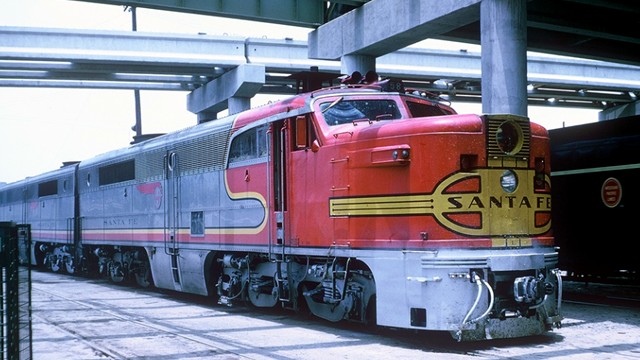January 10, 2012


The ALCO PA (and attendant booster PB) is the only diesel locomotive that should be allowed to stick around. The PAs first took to the rails in 1946, with the last of them being manufactured only seven years later. A total of 297 PAs or PB were built. While that sounds like a lot, in truth it wasn't. It had the misfortune of coming into the world at a time when ALCO was being soundly thrashed, market-share wise, by EMD and their nigh-on ubiquitous E-units and F7 locos (nearly 2400 "A" units built). Quite honestly, they couldn't compete.

To railfans, however, that doesn't matter. What matters is that the PA had character and style in a world that was becoming increasingly bland and lifeless. And considering how much its Model 244 turbocharged V16 2000hp (later 2250hp) engine smoked while accelerating, it may as well have been a steam loco.

Unfortunately, it was that same Model 244 engine that spelled doom for the PA. Rushed into production, it never had the bugs worked out and proved to be unreliable in service. Indeed, this dog of an engine ended up being the death of ALCO, as it never recovered from the reputation lost from the near-constant failures of 244s.

But none of that matters to a railfan. They're different. They're rare. They're quirky. All of that means that they're my favorite diesel loco. Alas, there are also very few left in existence... five, to be exact, two of which are in Mexico.
I know I have a few train fans out there (Ed Hering, please pick up the red courtesy phone) who are probably a lot more knowledgeable than I regarding this sort of thing. Please, chime in!
Posted by: Wonderduck at
09:45 PM
| Comments (12)
| Add Comment
Post contains 499 words, total size 4 kb.
I'm not as knowledgeable as I could be if I spent my scant free time somewhat differently, but I'm still a sucker for locomotives, particularly the classic age-of-steam. Let's put it this way: A while back I found a torrent of the most dreary, grainy, boringly-narrated series ever made about the waning decades of British steam rail, and I sat through the whole damned thing anyway. Every other year I make sure that at least one of my wall calendars features steam locos.
That is one stylish diesel, right there, yessir.
Posted by: GreyDuck at January 10, 2012 10:30 PM (eHm8o)
Why, yes, yes I did watch them all.
Posted by: Wonderduck at January 10, 2012 10:55 PM (f/6aJ)
I liked diesels because I understood the vast improvement in efficiency they represented. It required one man to operate rather than two or three, and the awesome THUD THUD THUD of the massive two-stroke engines operating at full speed was an amazing sound.
I didn't get interested in steam locomotives, in fact, until I began working on a novel that began with a kind of "steampunk" setting, in 2000; and thanks to that I now have some interest in them.
Posted by: Ed Hering at January 11, 2012 05:04 AM (4X4NQ)
Posted by: Steven Den Beste at January 11, 2012 10:10 AM (+rSRq)
Posted by: Wonderduck at January 11, 2012 02:32 PM (OS+Cr)
Posted by: Author at January 11, 2012 03:02 PM (G2mwb)
Posted by: Ed Hering at January 11, 2012 06:12 PM (4X4NQ)
You could never design something like that now. You could never get it approved, because of the noise and the pollution.
Posted by: Steven Den Beste at January 11, 2012 07:24 PM (+rSRq)
On the contrary, Steven, most of the rail diesels currently running are turbocharged two-strokes - one of the latest of which was the EMD710 (16-710G3C-T2), approved by the EPA for Tier II Emissions Spec in 2004. The engine met spec through EFI rather than mechanically-governed injection.
Posted by: JT at January 13, 2012 02:55 PM (iStSI)
In an engine using a carburator, the problem is how much gas-air mixture to blow through the cylinder when the valves are open. Too little and you have burned exhaust in your next compression cycle. Too much, and you have unburned gas in your exhaust. In the middle you pretty much get both.
But if all you're blowing is pure air (with a turbo, I can believe) then there's no reason to hold back. Really crank that baby, and end up with the cylinder full of clean air just before the valves close and the cylinder compresses.
Some (probably a lot of) clean air also blows right through and into the exhaust manifold, but so what?
Posted by: Steven Den Beste at January 13, 2012 09:13 PM (+rSRq)
Note that these 2-strokes still have the usual problem with NOx emissions. Aviation diesels simply ignore the problem - for now. I am sure that railway people use urea or other chemical to reform or capture the oxides.
Posted by: Author at January 16, 2012 11:57 PM (G2mwb)
Photo:
http://www.parovoz.com/newgallery/pg_view.php?ID=336167&LNG=RU#picture
Note the clean exhaust. The fuel is a liquified natural gas.
Posted by: Author at January 17, 2012 12:08 AM (G2mwb)
47 queries taking 0.5491 seconds, 288 records returned.
Powered by Minx 1.1.6c-pink.









